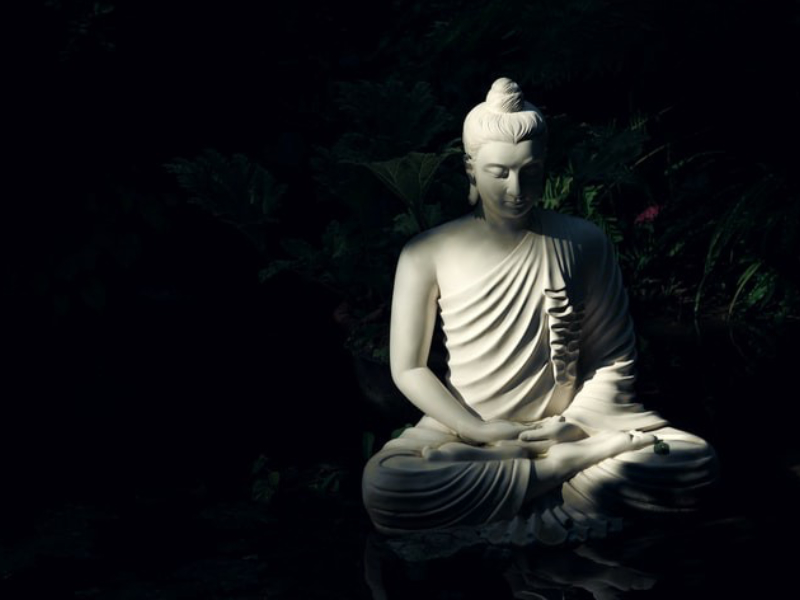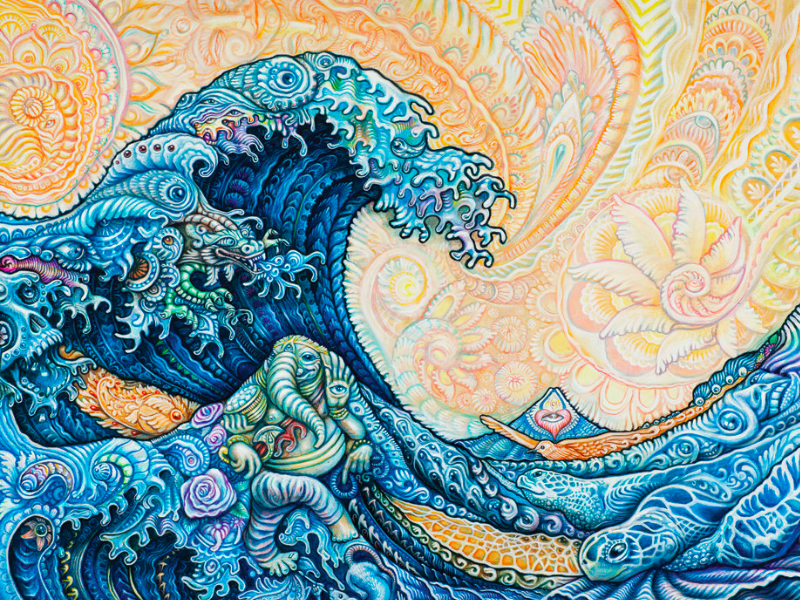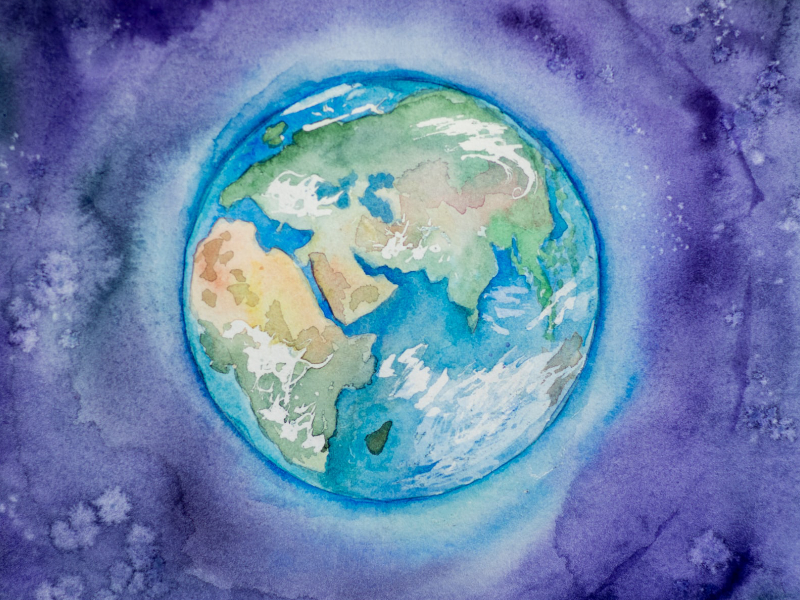When the Heart Touches Suffering
– The Noble Eightfold Path | Thoughts of Compassion –

OVER THE LAST SEVERAL WEEKS, we’ve been exploring the Buddha’s Noble Eightfold Path. More particularly, in the last few episodes we’ve been exploring one arena of our training along this path, training in thought.
In the last episode, I suggested that when you apply your understanding of the Four Noble Truths directly to your relationships with the world and to your relationships with others, thoughts of connection, kindness, and compassion would unfold. And then we went on to explore what kindness looks like both in the world and in our own heart and mind.
Today, we’ll explore how this loving-kindness expresses itself when it is confronted with suffering or dis-ease in ourselves and the world around us.
Thoughts of Compassion
Once we start to open to suffering and dis-ease in our own lives, once we become more familiar with the mind-body process and the cause of ill-being, we begin to see suffering everywhere. We realize that everyone around us is looking for the same peace, for the same freedom from this suffering.
And when we really allow ourselves to touch this suffering in others, we can feel and know directly that it is not apart from us. So, as we continue to move through the world, more and more we find in our hearts and minds the intention to alleviate suffering, in all its forms.
The full maturation of this aspiration is captured beautifully by the eighth century Indian monk Shantideva in his perennial work The Way of the Bodhisattva (bodhisattva means someone who embodies fully the intention to alleviate the world of its suffering):
“For all those ailing in the world,
Until their every sickness has been healed,
May I myself become for them
The doctor, nurse, the medicine itself.
Raining down a flood of food and drink,
May I dispel the ills of thirst and famine.
And in the ages marked by scarcity and want,
May I myself appear as drink and sustenance.
For sentient beings, poor and destitute,
May I become a treasure ever plentiful,
And lie before them closely in their reach,
A varied source of all that they might need.
My body, thus, and all my goods besides,
And all my merits gained and to be gained,
I give them all away withholding nothing,
To bring about the benefit of beings…
Like the earth and the pervading elements,
Enduring like the sky itself endures,
For boundless multitudes of living beings,
May I be their ground and sustenance.
Thus, for everything that lives,
As far as the limits of the sky,
May I provide their livelihood and nourishment
Until they pass beyond the bonds of suffering.”
— Shantideva, The Way of the Bodhisattva
No doubt, this aspiration requires great humility and patience. But really, it’s not so daunting as it seems. Rather than view it as some fanciful and far-off state, we can connect to and embody this intention every time we are mindful. We can witness suffering and transform it with Love. We need only plant the seed. Water and nurture it. And watch it grow.
“Though I do not believe that a plant will spring up where no seed has been, I have great faith in a seed. Convince me that you have a seed there, and I am prepared to expect wonders.” — Henry David Thoreau
What is Compassion?
Compassion is the heartfelt wish to alleviate suffering, both in one’s self and in others. It is what metta, or loving-kindness, looks like when it comes face-to-face with suffering or dis-ease — the realization and intention that you want this conscious entity to be happy, you want them to be free from suffering.
Compassion opens our hearts to the reality of suffering, within and around us, and creates the strong impulse in us to act. Thich Nhat Hanh called it a verb because of its responsive quality. It responds to suffering with wisdom from the heart, sometimes with fierce determination and courage, and at other times with patience and encouragement, and sometimes even with silence or non-doing.
* * *
Simple, right? Maybe in theory. But when many of us confront suffering, whether in ourselves or in another, we find it difficult to open to. Why? And how, then, can we start to let it in?
Compassion = Empathy + Mindfulness
Compassion begins with empathy. It arises out of our willingness to come close to suffering. For many of us, this can be extremely difficult. We may be aware of someone’s pain, or even our own, but we may not take the time to get intimate with it, to genuinely feel into and listen to it.
This really is a practice of its own. The problem is often that we have built too many defenses. We become indifferent, apathetic, or quickly withdraw to keep us shielded from the suffering. And very often we aren’t even aware we’ve built these defenses, so they stand as these great invisible barriers to compassionate response.
The good news, though, is that our vipassana practice can really help. When we cultivate mindfulness through practice, we cultivate a heart and mind that is open and receptive to whatever is arising, whether pleasant or unpleasant. We aren’t moved or bothered by things being a certain way. We accept and are able to be with the truth of things as they are, not at arms-length but fully and intimately.
Compassion, then, is a great gift of mindfulness. It helps us open to our empathetic nature with an open, receptive, and equanimous embrace. It allows us to let things in without drowning in or becoming overcome by the difficulty, the pain, the grief, or the sorrow. It enables us to embody that wide open, expansive, and freely given wish — may you be happy, may you be free from suffering.
* * *
The next time you confront suffering, pay attention to the mind’s reaction. What does it do? When there’s pain in the body, do you welcome it and open to it or do you pull back from it? Do you note it but not really give it your full attention?
What about when you confront emotional pain or distress, like discontent, fear, unworthiness, jealousy, or loneliness? Again, do you open to it or do you try to avoid it? Do you repress it, numb out, or turn to distractions?
What about when you interact with a difficult person or situation, when you experience racial, political, or religious injustice, or a natural disaster or tragedy in the world or your community? Do you withdraw from the person or situation or do you become interested in what’s happening? Do you try to listen to and understand the experience?
Often the response for so many of us is indifference. Our media and culture (really many cultures) have conditioned us for this response. Watch out for this indifference. Next time you come across a sick or dying person, or even some roadkill or a frown, see if you can take a moment to really connect with the fear, pain, or despair. Can your heart stay open? As Goldstein says, can you diminish the subtle cruelty of indifference? Can you make compassionate responsiveness the default setting?
The Open & Creative Field of Compassionate Response
In the West, we tend to be prescriptive about our morality. We look at our actions, even our compassionate responses, in terms of right or wrong. But compassion doesn’t work this way. There is no ‘right’ or ‘wrong’ or ‘good’ or ‘bad’ way to express compassion. There is no single response.
Yes, there are more and less efficient ways to accomplish our aims, which the “effective altruism” movement is trying to capture. But compassion is wide open. It can take on any number of an infinite set of forms.
If one person’s heart moves her to sit in a cave and meditate on the nature of suffering for decades and ends up sharing her insights with only a few students, it’s unhelpful to judge her compassionate response or compare it with another’s. Maybe one of the students she shares her wisdom with becomes the next Thich Nhat Hanh, a great peace activist in the world.
The field of compassion is limitless. There is no particular prescription for what we should do, no hierarchy of compassionate action. There is space for each of us to find our own way, through the natural and spontaneous expression of heart that is free from self-reference, free from greed, free from hatred, free fom delusion.
Conclusion
Compassion is the activity of a free and liberated heart. It is the expression of understanding the Four Noble Truths, the expression of wisdom, the result of witnessing directly the seamless and interconnected nature of being. The more we grow into emptiness, the more natural compassion becomes.
As Dilgo Khyentse Rinpoche said, when we recognize the empty, selfless nature of phenomenon, “the energy to bring about the good of others dawns uncontrived and effortless.”
May you be free from suffering,
More Articles
“The Art of Bare Attention”
Today we’re going to talk about the ancient Buddhist practice vipassana, or insight meditation. Now, just to be clear, this is an entirely secular practice. It doesn’t require you to adopt any dogmatic beliefs…
“The Faceless Seer”
How do you hold your love? Do you hold her from stillness, with nowhere to go, with nothing to do? How do you hold your love? Do you hold her with acceptance, with open hands and arms, with unabashed…
“Everything Changes”
It’s no secret everything changes. Your experience this morning isn’t your experience now. Yet how many of us act like we really understand this? How often do we grasp onto the illusion of things…
“The Divine Connection”
How do you hold your love? Do you hold her from stillness, with nowhere to go, with nothing to do? How do you hold your love? Do you hold her with acceptance, with open hands and arms, with unabashed…






